One Of The UK's Leading Specialists In Victorian Tile Conservation And Restoration
Rhwng y Ddwyryd, Waunfawr, Caernarfon, Gwynedd. LL55 4EZ
Covid 19. During this period of restricted travel and social distancing precautions we have temporarily discontinued our normal operations and will not be working away from our base. To ensure the safety of our clients, customers and suppliers we will only be working through remote communication. Please use our email info@rieveleyceramics.co.uk or phone 07747 394280 or 01286 650702 for advice and enquires. There is further advice and information on the website and our Facebook page.
We look forward to resuming our normal services when conditions allow. Please take care to look after yourselves and others.
For regular updates see our Facebook page https://www.facebook.com/rieveleyceramics?fref=ts
Saw us in Llanarmon Nr Pwllheli carrying out work on yet another floor with tiles by J C Edwards. Also a mixed quarry tile and geometric/encaustic hallway in Caernarfon.
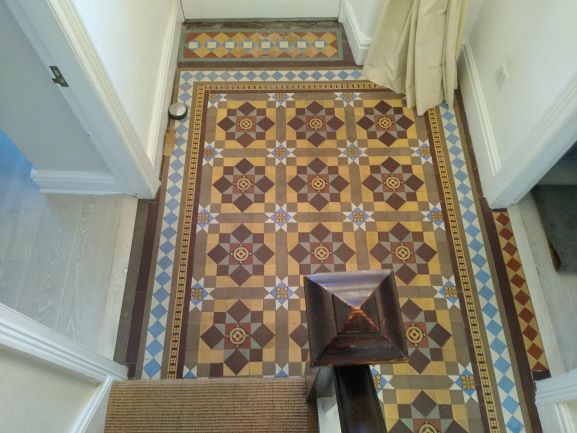
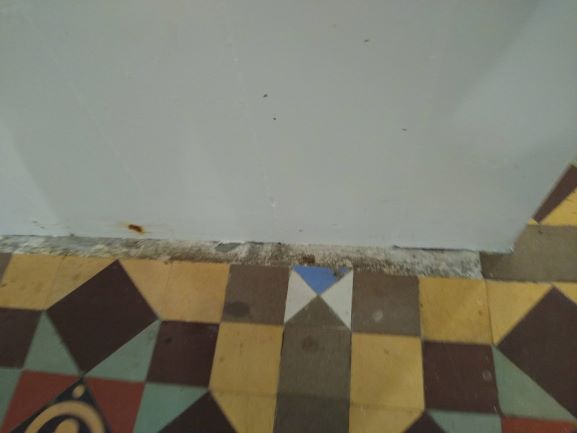
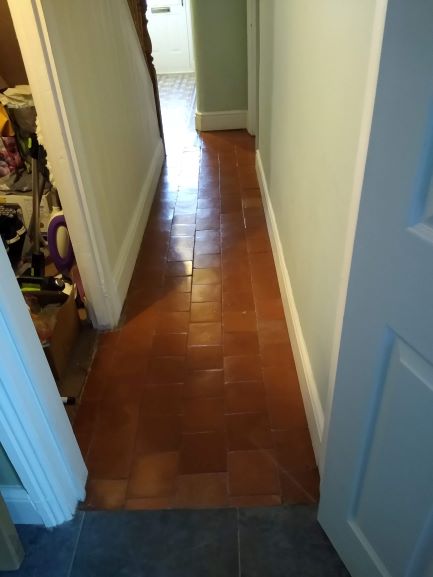
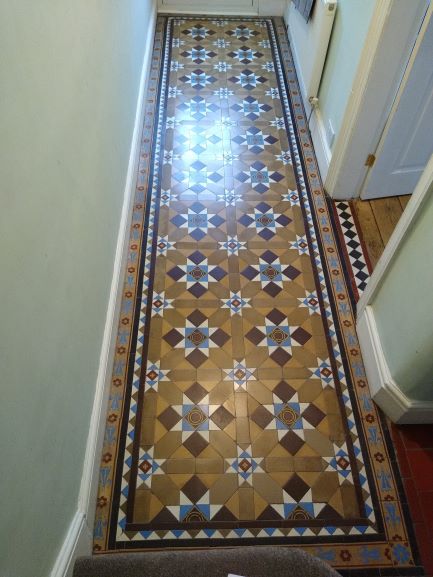
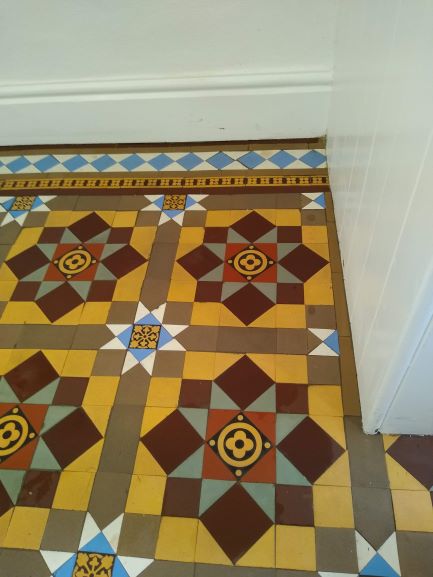
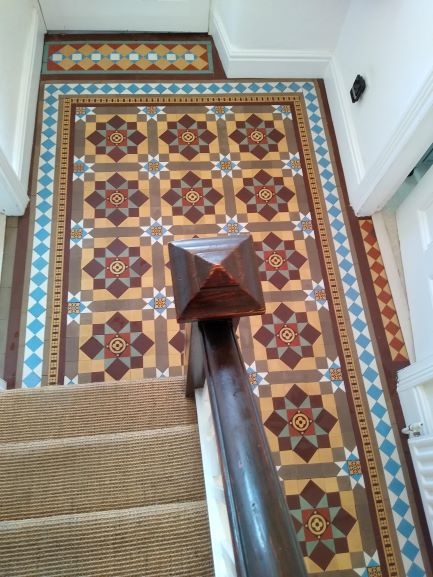
Sees the completion of restoration of another J C Edwards geometric/encaustic floor in Bangor, N Wales. The work also required the addition of replica tiles following building alterations. Matching replica geometric tiles were sourced. Because the encaustic patterns were not readily available, and the costs of making in the traditional manner would have been prohibitive, on this occasion we used a screen printing technique with a ceramic engobe that was fired onto the tile.
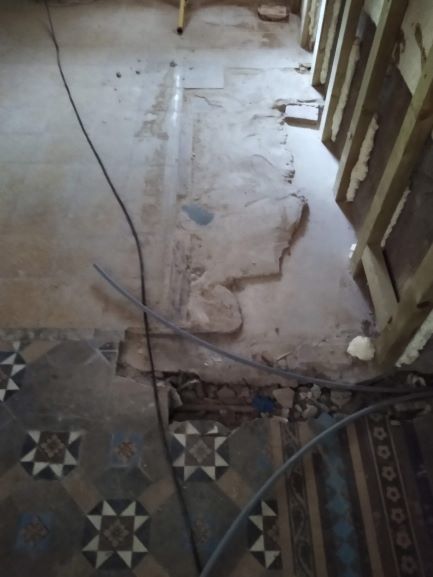
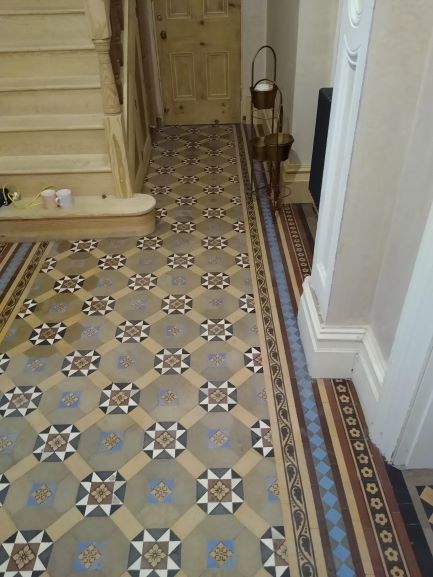
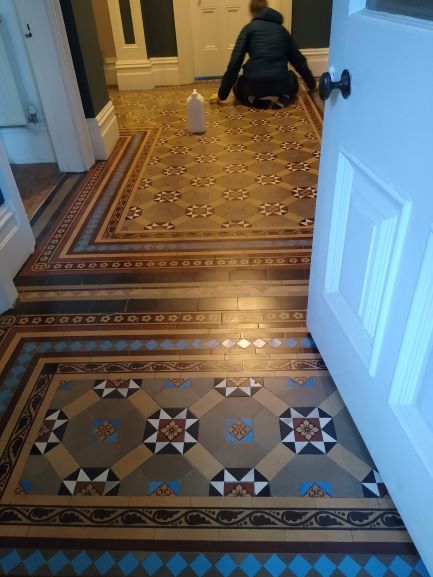
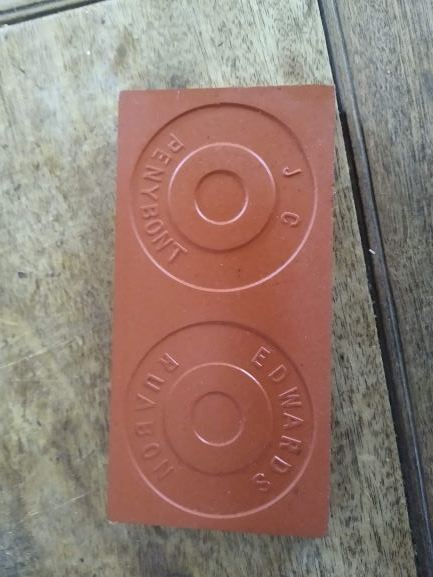
We completed the restoration and conservation of the fine encaustic tiled floors at Withnell Hall, Nr Chorley, Lancashire. The end of an ongoing project over a two year, period as reported in previous posts. The final phase being the "atrium" floor, a large central hall, which surrounds the re instituted staircases. We carried out repairs and replacement of tiling using some of the reclaimed tiles we had previously lifted and were surplus due to a rearrangement of the former entrance hall that were a part of the redevelopment. Then when the building work involved in the redevelopment of the property had been completed allowing access to the tiles, we were then able to restore the "atrium" floor to its former glory.
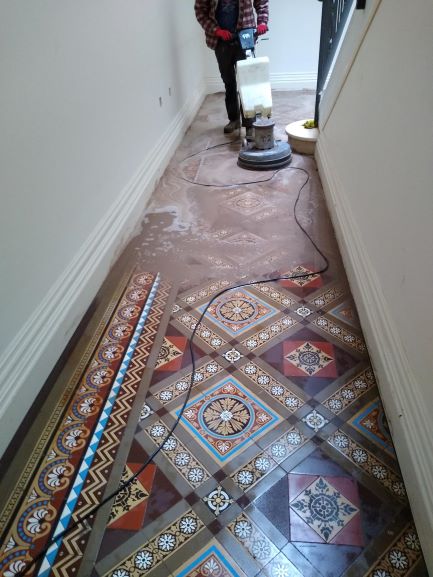
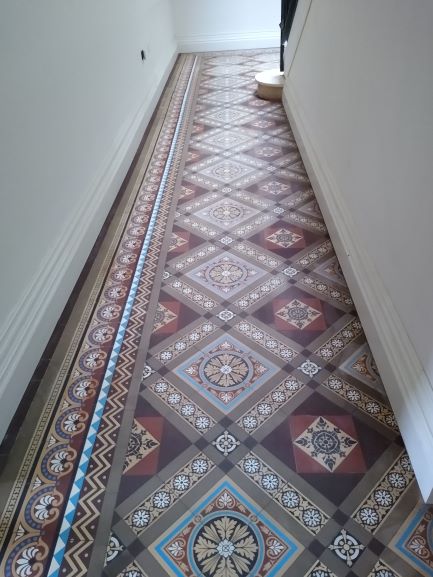
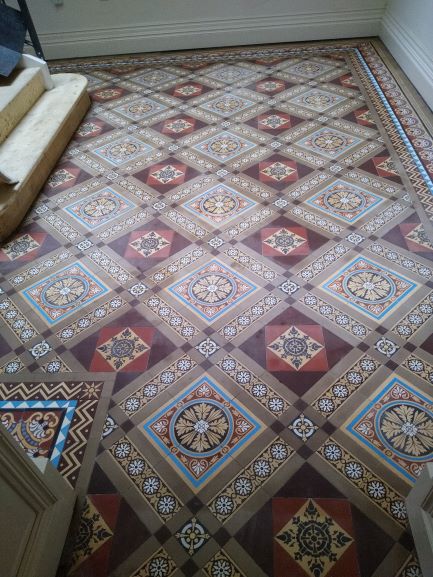
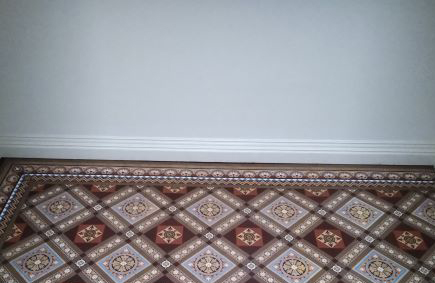
The Jonah Jones mosaic, we rescued from a church in Morfa Nefyn at the beginning of the year for the Catholic Diocese of Wrexham, was delivered from our workshop to the new location decided upon for this important religious artwork. The newly built Catholic High School in Rhyl. There was a lot of activity on the site, run by the main contractors Kier Construction, with work both inside and outside being carried out in readiness for start of the schools new academic year starting in September.
As we installed the mosaic, which has been placed on 12 portable panels following its removal from the original location, it aroused curiosity and a great deal of interest from those working on site and visitors, many school parties and teachers were being escorted around to view the new school. I am pleased to report the Jonah Jones mosaic was met with great approval and the work of this innovative artist can go on to influence and inspire future generations.
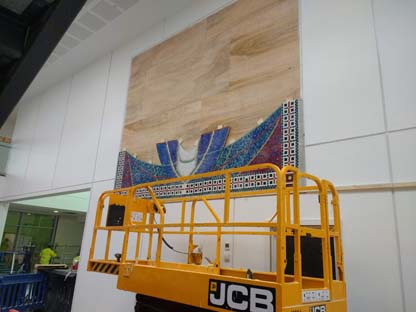
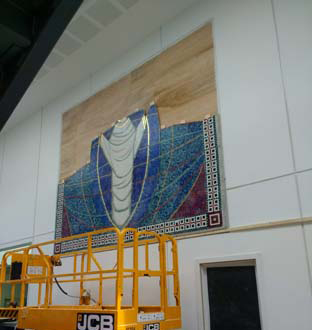
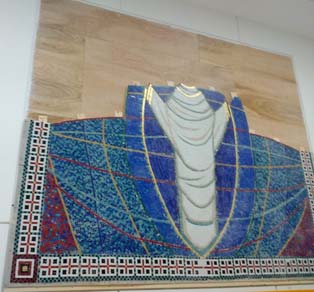
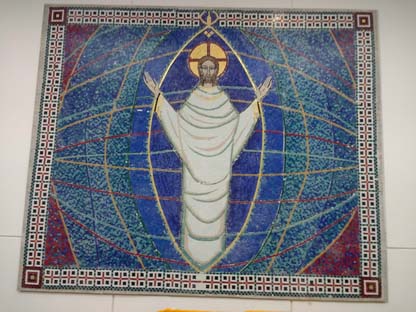
Work on preparing the Jonah Jones Mosaic continued in our workshop to ensure all would be ready for a date in July when we could reinstall it at the new location in Rhyl.
We found ourselves closer to home working in Caernarfon restoring a geometric hall floor. An unusual manufacturers name appeared on the tile backs, Henry C Wood, Worcester. A large area of these tiles had been taken out at some time and been replaced with ill matched 6 inch quarry tiles, further problems of subsidence of the underlying substrate and loose and damaged tiling existed on the parts of the floor where the original tiles were still in situ.
The quarry tiles covered an area of around 6 sq metres which were taken up. The subfloor beneath required extensive work, much of it being replaced with concrete and a cement screed before replica tiling, matching the Henry C Wood originals, were put in place. On this occasion a decoupling layer was installed to help speed up the process by not having to delay for 2 months to allow time for the new subfloor to cure. Smaller areas of collapsed subfloor around two door thresholds were also repaired with loose tiles being taken up and cleaned.
The cleaned tiles were replaced into their original positions on the floor although due to damage a few replica tiles were placed among them. The area on which had been quarry tiles was re tiled with replica tile that matched the originals so that the new tiles form a seamless and unnoticeable change between old and new.
We also undertook the restoration of a cast iron fireplace at the request of the client.
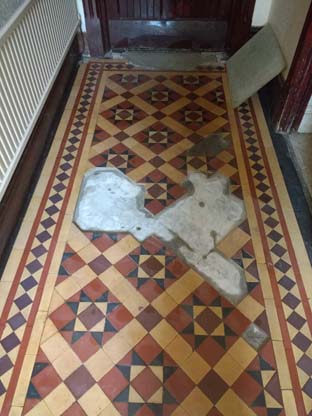
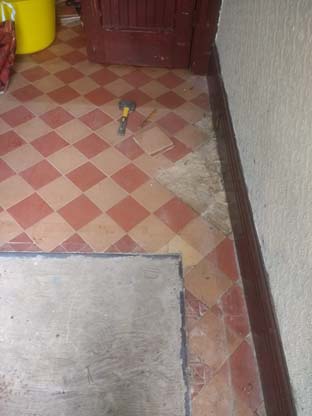
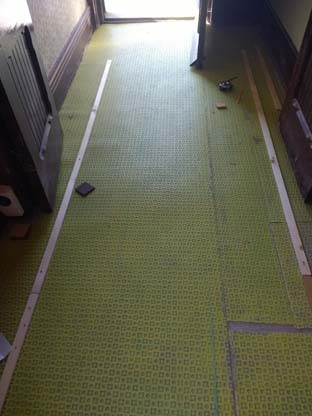
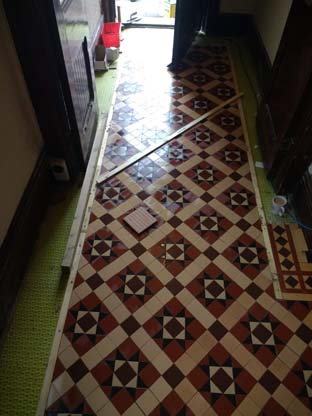
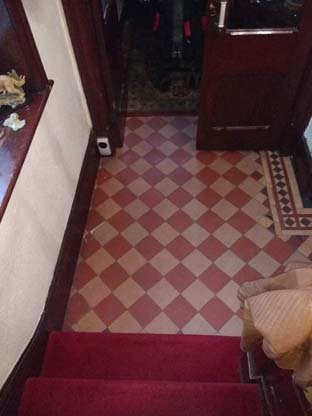
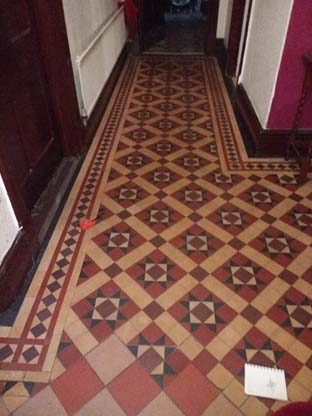
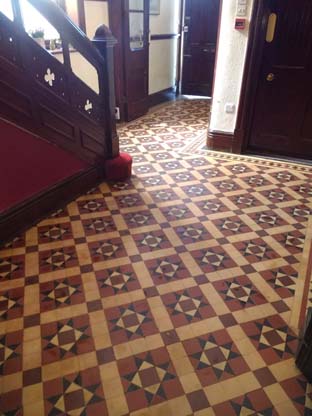
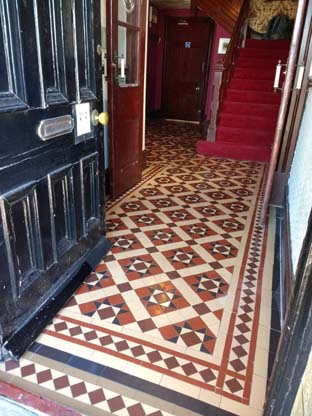
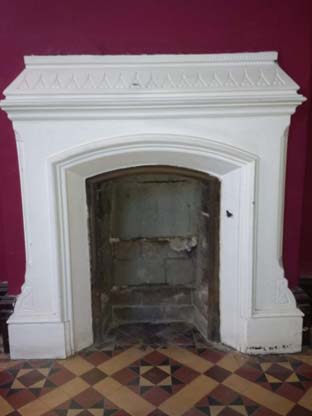
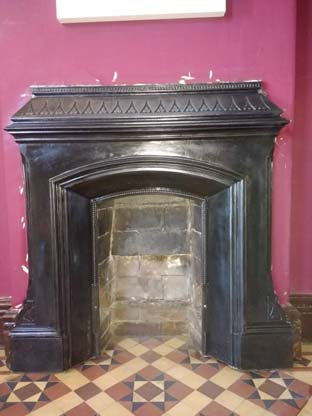
Rieveley Ceramics returned to Withnell Hall near Chorley to reinstall the encaustic tiling that we had taken up from the floor 12 months previously so that work could be done to the subfloor including the addition of underfloor heating. The property is being developed by Brindle Homes to provide luxury apartments within the old 19th century, once derelict, building. Brindle Homes were keen to retain the tiles as an original feature within this historic building.
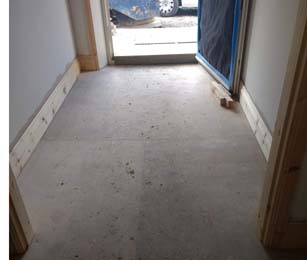
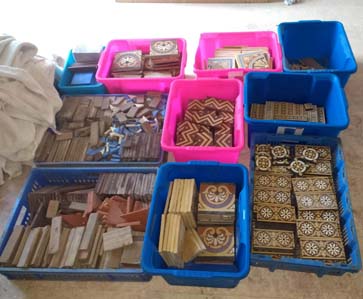
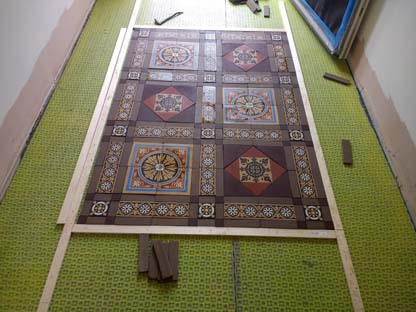
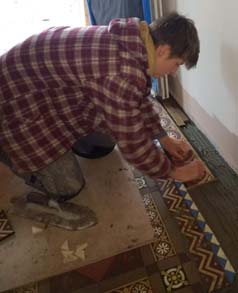
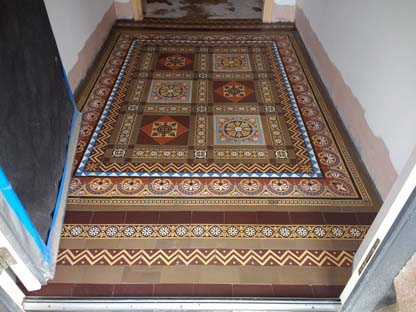
Work on Withnell Hall is continuing and we expect to be back in few months to carry out further work on a large area of encaustic tiling on the floor of the central "atrium" which forms a hall and stairway within the centre of the building.
Restoration and conservation work on a geometric encaustic floor at Great Barrow, Nr Chester, was also undertaken during this period. The tiles were manufactured by Maw & Co Broseley. At the request of the client an area of the original tiling was taken up from a concealed part of the floor within an understairs cupboard which were then used to replace the damaged tiles.
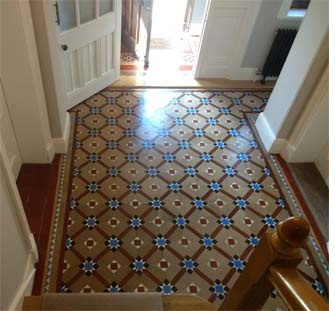
A successful conclusion to the first phase of work on the Jonah Jones mosaic.
At the behest of the Catholic Diocese of Wrexham we have been involved over the past few months in preparation for and completing the removal of a large wall mosaic before the building in which it was housed is demolished. The magnificent mosaic forms the centerpiece of the decorative design by the artist Jonah Jones, which also includes twelve stunning "Dal de Vere" stained-glass windows, for the Church of the Resurrection of our Saviour. It is sad that the work of the artist is unable to remain in the building for which it was intended however the diocese is ensuring their survival and they will all eventually be found suitable re locations by the Catholic Church.
Removing the mosaic was a daunting task, measuring over 3.5 metres in height, over 4.2 metres wide and made up of around half a million individual tesserae, a great deal of preparatory work was needed on the materials and methodology to be used. Consultations with other conservation professionals took place through the Institute of Conservation (ICON), nonetheless given the somewhat unique nature involved in removing this particular piece a lot of investigation was required before starting the removal.
The actual removal took place over a five week period as the mosaic was gradually taken from the wall and finally fixed to a new backing material that has been sectioned to follow the curves of the design, also allowing the mosaic to be taken from the building and will be used to form the support in the new location. It will also enable the mosaic to be easily taken down and reassembled should the need ever arise in future.
The project has also proved an invaluable experience to our apprentice Alex, and good grounding for the qualification in conservation that he is taking with the Victoria and Albert Museum. It was fortunate that the assessor for the V&A was able to visit whilst he was working on the mosaic.
The mosaic is now in storage following its successful removal from the church and is awaiting the completion of its new location where we will reinstall it and once again it can be seen and appreciated in its full glory.
The photos below illustrate the work as it progresses.
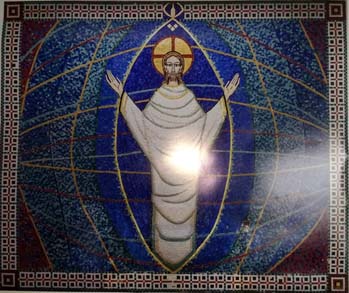
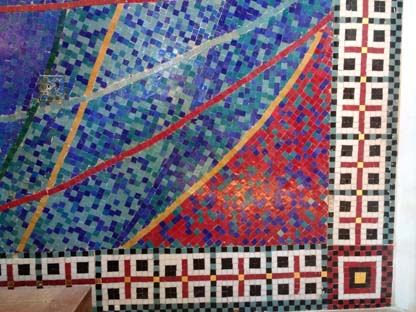
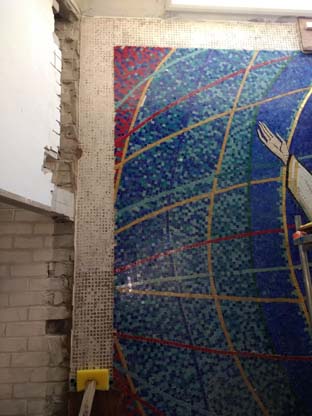
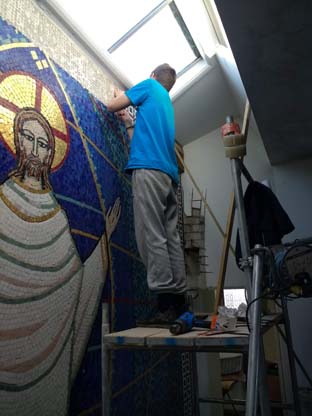
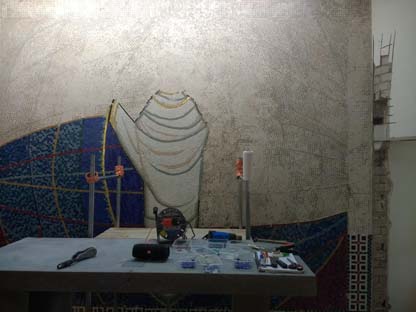
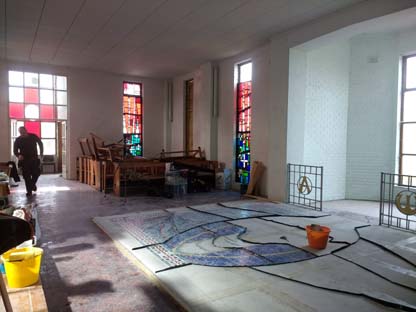
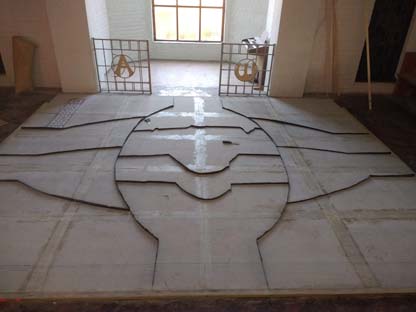
A busy time of year as clients want work completing for Christmas and New Year saw us working on terrazzo tiling in Beaumaris on a recently purchased retail premises carrying out alterations and repairs along with re polishing so the new shop could open for trading during the busy pre Christmas run in. December we were carrying out work in Criccieth, Llandudno and Chester on Victorian and Edwardian floor tiles in a number of domestic homes.
Late December we started some early preparation for an unusual and exciting new project to remove and reinstall a large mosaic artwork by Jonah Jones. Jonah Jones (1919 to 2004) although originally from the North East of England came to live and work in North Wales which he adopted as his native country imbibing its culture, language and landscapes. Perhaps better known for his sculptural works and carved lettering his artistic talents extended in many directions as well as painting, drawing, lettering and illustration he also was an author and biographer. He carried out a large number of religious works and was commissioned by the Catholic Church on numerous occasions with works in churches and religious institutions in many places throughout the UK.
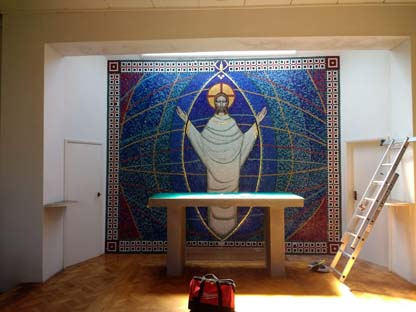
The mosaic is relatively modern as is the church in which it is currently located, being completed in the late 1960's. However the Church and surrounding land is to be purchased by a developer as it is no longer required by the local Diocese as the congregation for this church as with others has dwindled it was felt no longer practical to keep it. However it was decided to save the mosaic along with 12 stained glass windows, also by Jonah Jones, for relocation elsewhere. The removal and re installation of a mosaic of this kind has not often if ever been done and the complex nature of the work involved is expected to take a number of months before completion.
A number of projects in private homes were undertaken in Colwyn Bay, Rhos on Sea, Llandudno and a somewhat unusual one involving a gravestone in Abersoch.
The house in Abersoch, the original building dating back to the 16th century with various alterations through the centuries, has a quarry tiled floor on the ground floor in the older parts of the property which consists of three rooms. The quarry tiles will have been put in around the 1930's and had been partially carpeted over there was also an area within the kitchen where the quarry tiling stopped and there was a rough concrete and cement infill in which there was also the gravestone. It is thought this area would once have had an old kitchen range which had been removed and in its place now stands a much smaller Rayburn oven. As to how, when and why the gravestone was placed there is unknown.
There were other areas of the quarry tiles which also needed repair and alteration, a mat well at the front entrance was to be removed and matching tiling put back and a hearth for a wood burner in the sitting room needing a tiled edging. In the kitchen the rough concrete and cement render infill was again to be replace with quarry tiles.
As excavations were underway it became apparent that the stone was a great deal larger than first anticipated as much of it had been hidden beneath a thin coating of cement. The area had been overplayed with carpets and rugs and there was evidence of damp around the exposed part of the stone which was discoloured, and covered in dirt, paint and patches of cement, there was however noticeable incised lettering though it was partially obscured by the poor conditions. The gravestone had been laid directly onto earth and the soil came up to floor level around the edge, an obvious source for the damp. Due to the size and weight of the stone it was impractical to try to move it in any way so a DPC was put in around it then the rest of the subfloor brought up to a level to allow the matching tiling to be put in. meanwhile work proceeded on the other repairs and finally all tiling was completed.
All the floors were cleaned and grouted before protective impregnates and polishes applied to enhance their appearance, whilst protecting and make for easy maintenance. The stone was also cleaned removing dirt, mortars, paints, tar, etc and then a conservation grade stabiliser was put on to strengthen friable areas. The stone has in parts clearly legible incised lettering, the earliest dated 1705. The date 1766 can also be seen yet it is the older script that has survived best as erosion has removed much of the lettering.
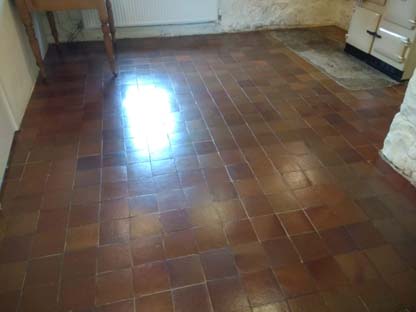
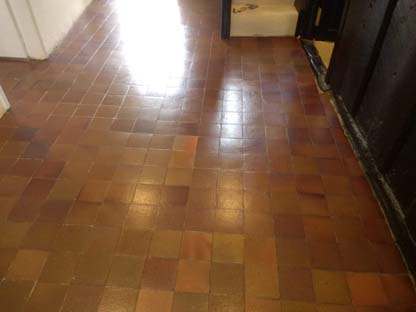
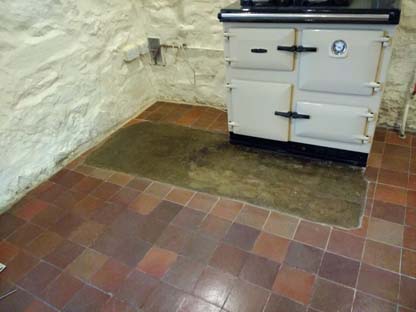
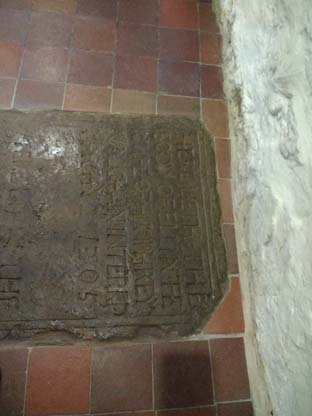
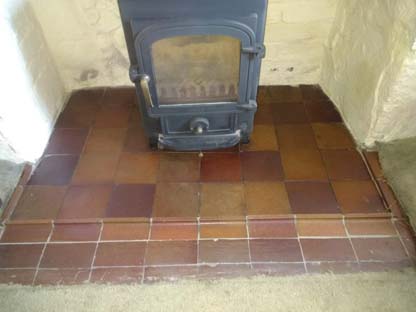
A quick return to the Victoria Gallery and Museum in Liverpool to inspect the tiled columns within the entrance and reception area. There were fears that tiles on the columns were in danger of falling and they were being temporarily kept in place with a wrapping of cling film. There was a thought that the recent unusually hot weather and raised temperatures had suddenly caused this however on inspection it became obvious that this was a longstanding problem and damage to the tiling that had taken place a number of years ago was the reason for the problems.
The tiles which are embossed, shell shaped and curved to facilitate the encircling of the columns had numerous cracks and fractures with missing pieces of ceramic and glaze. There were previous attempts at repair and overpainting which had created some of the problems that had led to the tiles delaminating from the background. The previous filling and adhesive used had increased the size of individual tiles and in consequence they no longer fitted and stood proud leaving a gap between them and the substrate.
All loose tiling was removed and taken away. All but one of the tiles were broken and the previous repairs that were still in part holding them together were removed in order that they could be reconstructed to enable theme to sit comfortably back in position and to remove discolouration and ill matched repair work.
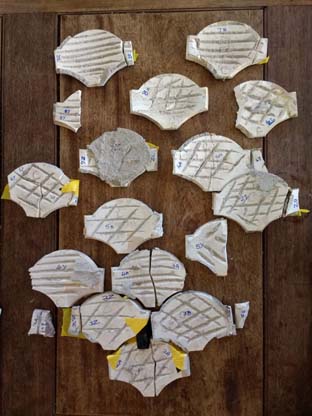
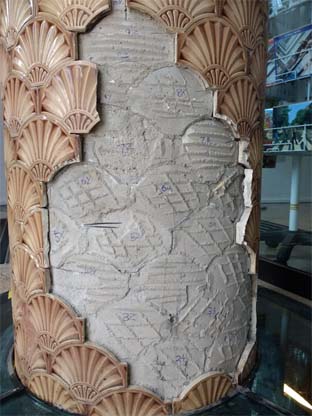
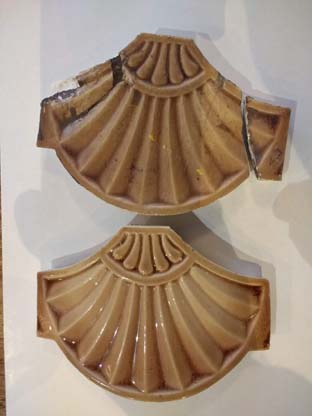
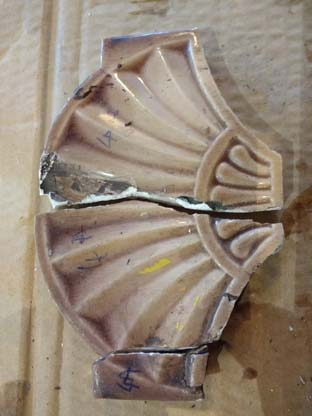
The column shown following the re installation of tiling.
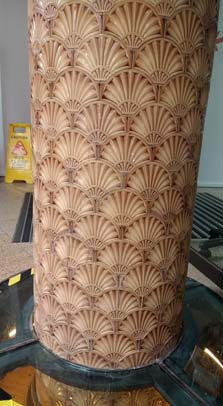
Back to Llanwrin nr Machynlleth to reinstall a geometric hallway which had been lifted some while ago whilst a new subfloor with underfloor heating was put in.
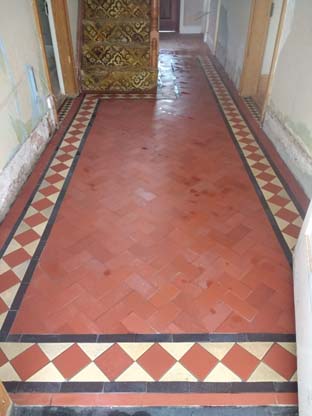
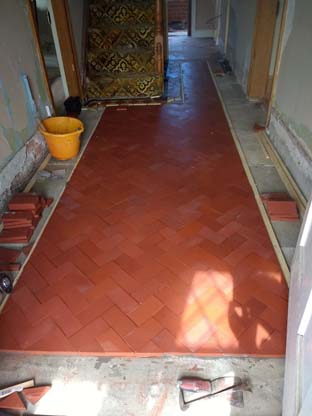
Reinstalling the original tiles, after they had been taken up and cleaned, onto the new underheated subfloor.
Earlier in the year we were called in by Liverpool University to inspect some damage to tiling at the Victoria Gallery and Museum. The gallery and museum occupy a building on Brownlow Hill in the part of the original university buildings designed by Alfred Waterhouse in which there is a magnificent tiled interior made by Burmantofts of Leeds. The gallery and museum is free to the public and well worth a visit for the tiles alone.
There had been some sort of an accident where there had been a collision that had knocked tiling from the wall and caused damage as well to tiling that had remained in place. We were presented with a large plastic bag in which the shattered remains if the fallen tiling had been collected. The initial task was to take this away and then painstakingly piece together the broken shards. Once this had been done the missing chips of ceramic and glaze were filled, smoothed, then painted and cold glazed before returning them to the Victoria Gallery to be put back in position.
Further work was also needed on those damaged tiles that had remained in situ. Being a listed interior it was important to retain and conserve the original material where possible and we were able to achieve this.
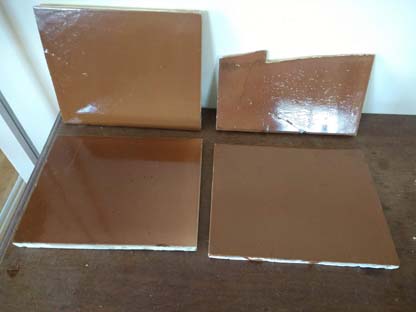
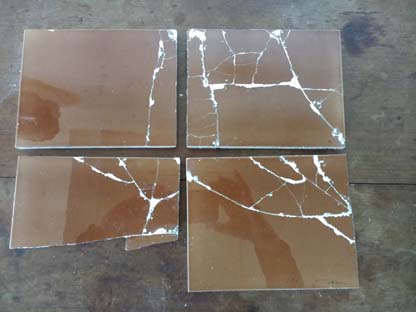
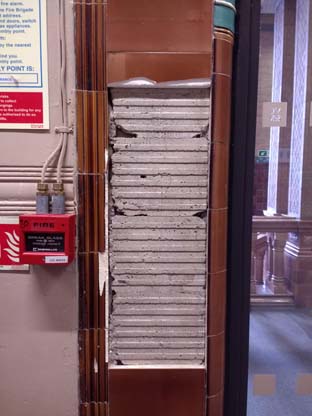
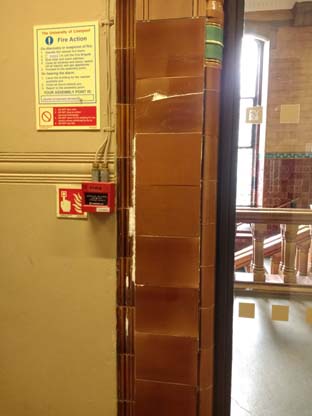
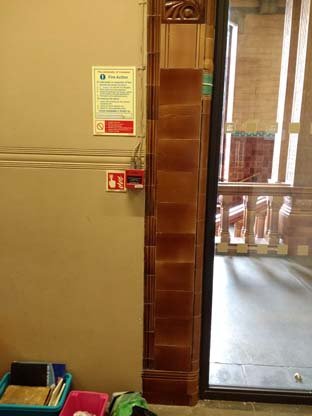
Numerous projects were worked on, largely for private clients within their own homes. These included two Anglesey farmhouses, one nr Llandyfrydog with an encaustic/ geometric hall, the other near Menai Bridge a quarry tiled kitchen. Another trip to Stockport to a geometric tiled hall and to Leek in Staffordshire to work on both geometric and quarry tiled floors. Ongoing work took us back to Llanwrin nr Machynlleth and in Harwarden a black and red chequerboard hall was restored.
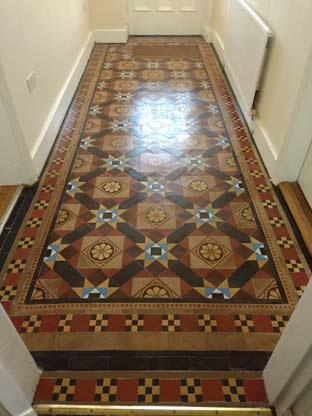
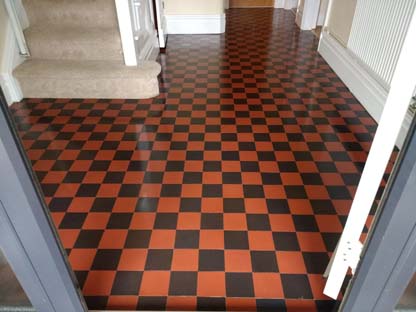
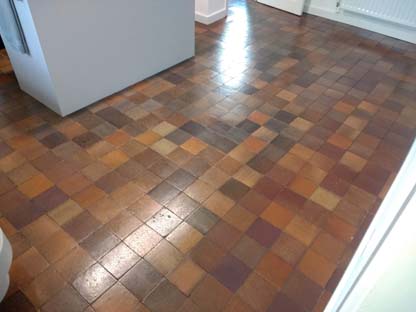
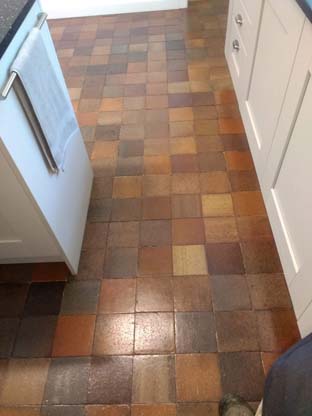
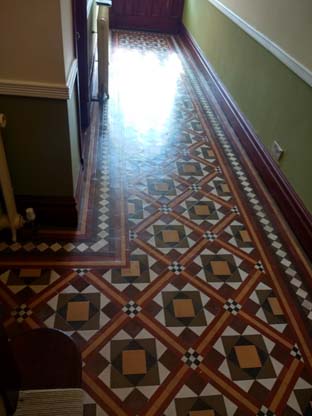
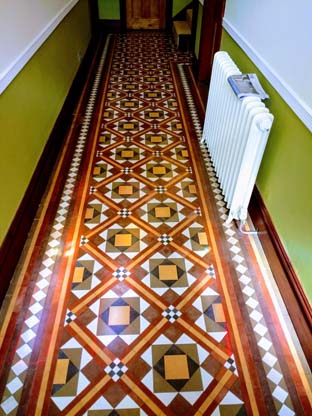
Saw Rieveley Ceramics in Lancashire near Chorley to start initial work on the restoration and conservation on a large area of encaustic floor tiling. The tiling was in a former mansion built in the 18th century that had fallen into serious disrepair and is now being redeveloped to create luxury apartments. On an initial visit it could be seen that practically the only bit of the internal decorative fittings left in the building were the encaustic tiled floors that extended from the entrance hall into a large "atrium" that acts as a central hall with access to the adjoining rooms and would have contained the stairs to the upper floors. The building has been stripped of all its internal fittings including those stairs, ceilings, floors, windows, plaster rendering, etc.
The intention is to retain as much of the encaustic floor as the plans for the redevelopment allow and this meant the tiles in the entrance hall had to be lifted to be reintroduced onto a modified entrance hall at a later stage. The removal of these tiles was the first phase of this project which is currently planned for completion early in 2019. The tiles proved reluctant to be parted from the tenacious grip of the Portland cement substrate and grout but fortunately with care, patience and knowhow we successfully managed to free them. Then following the removal of traces of cement mortar and grout from the tiles they were stored away for their future re installation.
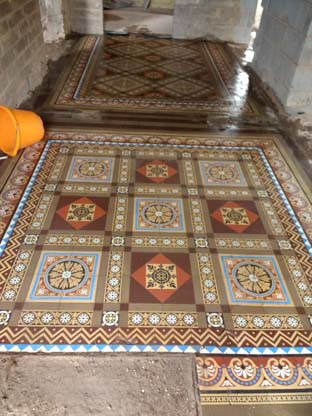
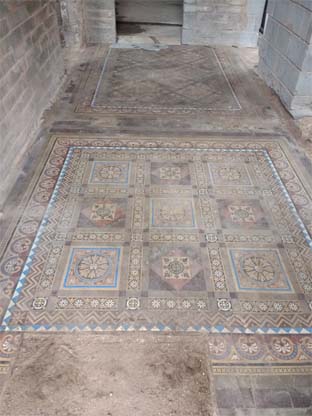
The above shows the entrance hall tiling on first inspection and following an initial surface clean.
The Atrium tiling was at the time covered in a protective layer of plywood partially covered by scaffolding and only small areas were visible, however it is believed to be in relatively good order other than needing some minor repairs where radiators have and piping were removed. The intention is therefore to leave the tiles in place where restoration and conservation work will bring them back to their former glory and maintain them well into the future.
A new installation of geometric tiling was undertaken in a Victorian villa in Stockport. The project was tiling an internal and covered external porch at the entrance to the house. With input from the client the design was based on tiling at the nearby Lyme Park.
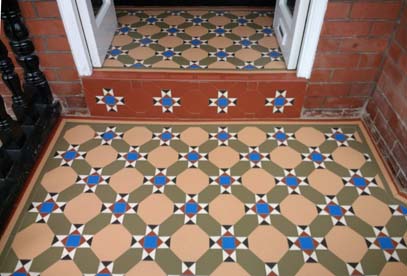
It has been quite some time since the last post but here are some photographs of some of the Conservation, Restorations and work undertaken since November 2017to give a flavour. More details will be posted soon.
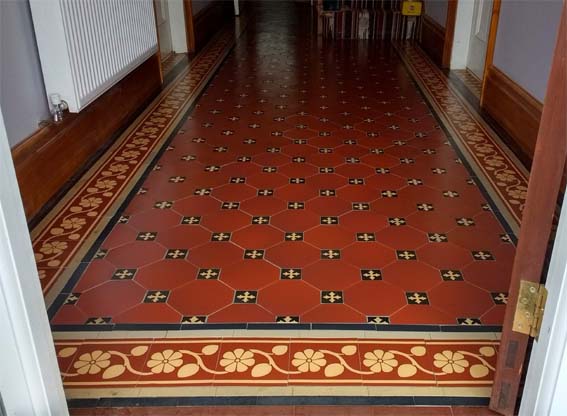
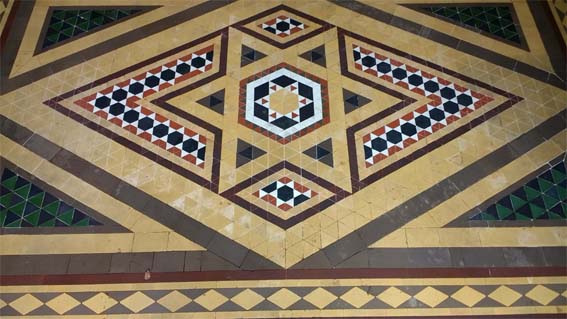
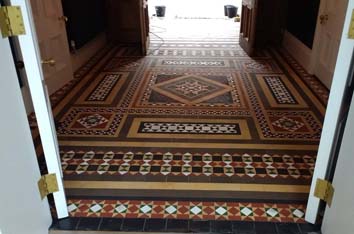
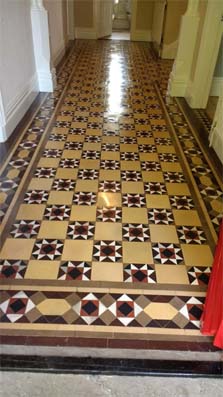
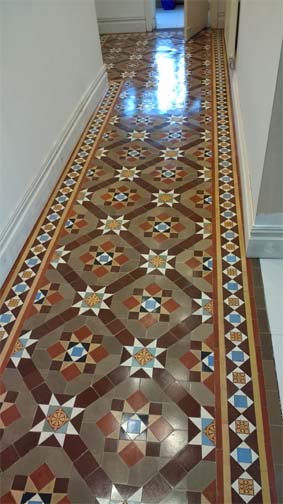
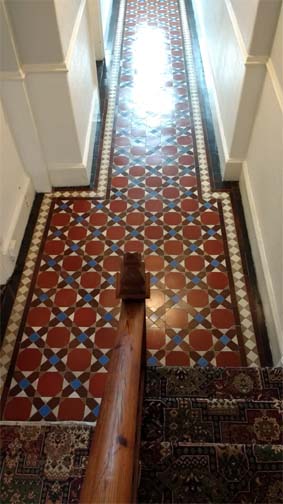
Peniarth Uchaf
Nr Tywyn
Restoration and re-laying of the tiled entrance hall.
The former home of the Corbetts, a listed manor house in the picturesque setting of the Dysynni valley, is currently undergoing extensive refurbishment after moving to new ownership. Part of which entailed the removal, restoration and replacement of a tiled floor with a highly decorative encaustic tile border manufactured by Maws. Circa 1880's. Due to the listed status great care was taken in retaining as much of the original tiling as possible.
Following extensive cleaning Conservation and restoration the tiles were relayed ensuring they matched the pattern of the original design of the floor.
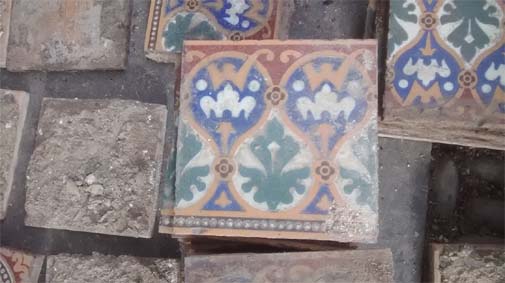
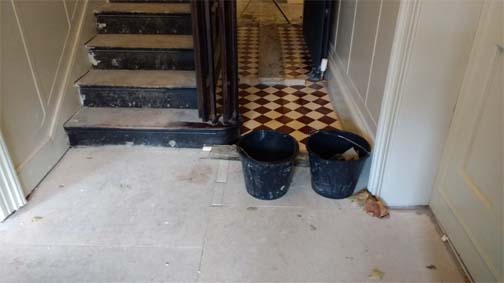
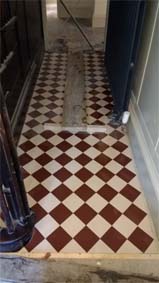
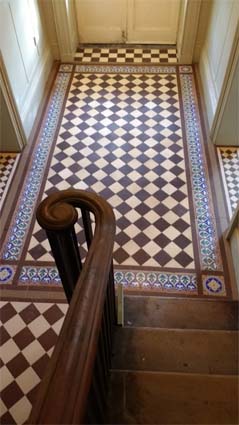
Restoration and extension of a Geometric/ Encaustic tiled hallway.
New Moston, Manchester.
The original tiling in the hall ended at the at a line at the foot of the stairs and the rear area, which had probably been tiled in the past, had been levelled with a cement render infill and covered with laminate flooring. After removal of the laminate work proceeded on the subfloor. The hall was on suspended floors above cellar spaces and this had to be taken into account with regard to flexing. There was also a stepped drop from the adjoining room to be accommodated so that both floors flowed through to one and other without a discernible drop.
There was also an area of the original tiling that had subsided and had to be removed and repairs made to the subfloor to re level those tiles. When the problems with the subfloor had been resolved tiling commenced.
Replica encaustic tiles that matched the originals were specially made by Craven Dunnill Jackfield and because the geometric tiles were not of a standard size, in order to match the original each tile was individually handcut.
Further work was required on repairing and replacing the tiling in the door thresholds and the original tiles were cleaned and restored. Finally protective finishes were applied to both the new and original tiling.
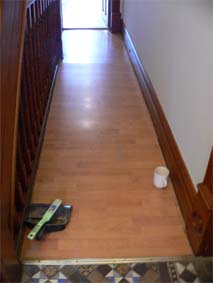
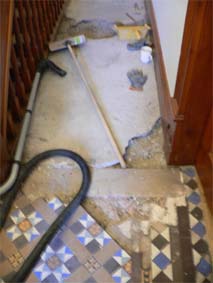
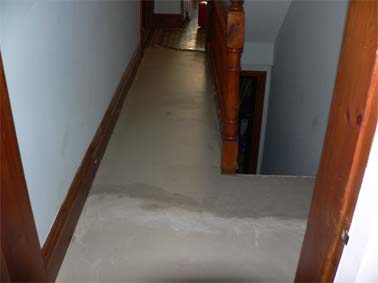
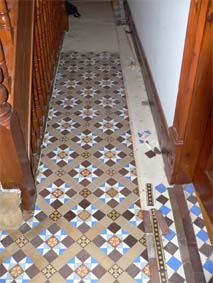
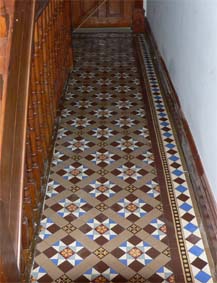
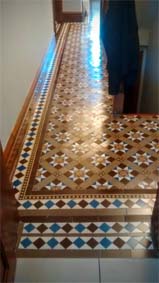
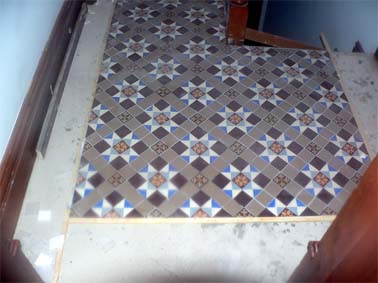
Restoration of a tiled fireplace.
During the refurbishment of an Edwardian period property in Llandudno a decorative tiled fireplace was discovered and need of some help to restore it to previous condition. The owner contacted Rieveley Ceramics and on inspection it was decided to leave the tiles where they were and carry out the restoration in situ.
Following cleaning various cosmetic repairs to damaged tiling were carried out, filling, repainting and reglazing, to bring the fire place back to its former glory.
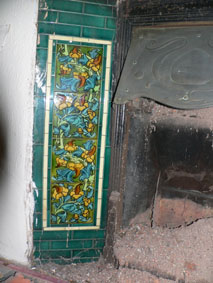
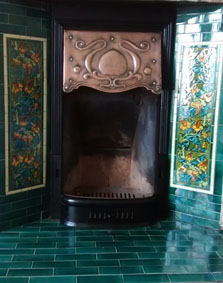

Completion of a project in Pwllheli on the Lleyn peninsula. The work undertaken was in a privately owned residential property in an elevated position over looking Pwllheli with extensive views over Cardigan Bay, that had initially been the home of a former sea Captain. The design of the Geometric/Encaustic tiled floor, made by J C Edwards of Ruabon, with its use of compass rose encaustic tiles and the nautical maritime appearance made up of pennant and flag like geometrics certainly hint at the profession of the house's original owner.
The hall tiling when originally laid had taken into account various partitions that overtime had been removed leaving something of a mis mash of tiles where quarry tiles formed the rear of the floor. The project was to unify the floor by restoring the grand entrance design and extending into the other areas.
Quarry and other incongruous tiles were carefully removed and retained with a view to future use and the geometric J C Edwards tiling taken back to a point from which the matching extension would blend in. Then following a levelling of the exposed subfloor the replica tiling was cut to size and installed to complete the extension.
Following grouting, the tiles were then treated with an impregnator and protective layers of satin finish for both protection and ease of future maintenance
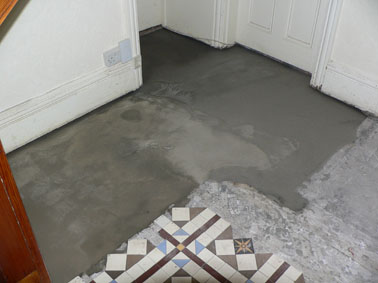
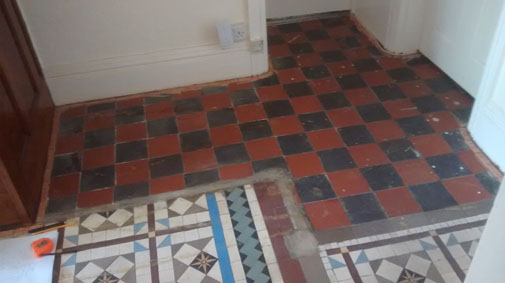
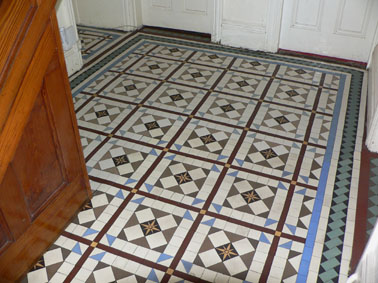
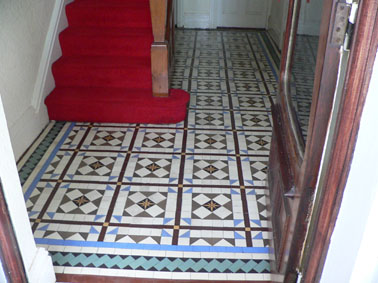
Restoration of a geometric tiled floor at Middleton near Manchester. The floor is in the entrance hall of Sunny Brow Nursery School housed in a grand Victorian building with extensive grounds. The school itself is innovative in its approach to developing and teaching of young children with its highly regarded Forest School. The building was formerly the childhood house of the architect Edgar Wood known for his innovative and at the time futuristic architecture on a par with the likes of Charles Rennie MacIntosh. Most of his buildings are listed and a large number are in Middleton.
The original tiles were made by the Hereford manufacture Godwin. They were unfortunately in a sorry state with many tiles broken and the uneven surface indicating structural problems below. Consequently, following the removal of a thick residue of coatings that had presumably been applied in an attempt to stabilise and damp proof, all the tiles were taken up to be cleaned, reclaiming as much as possible of the original tiling.
The underlying concrete/mortar was removed to reveal a brick sub floor. Following a certain amount of levelling with a quickset concrete screed a damp proof membrane was laid down and the floor was then brought up to height using a fibre reinforced cement leveller onto which the tiles would be relaid.
To retain the overall look of the original tiling the reclaimed tiles, from Constituted around two thirds, were intermixed with matching replica tiles during re installation.
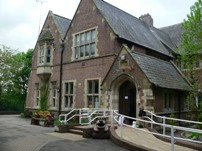
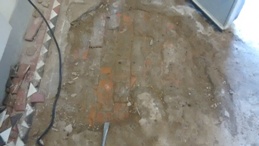
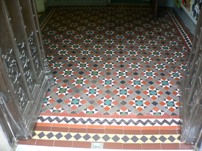
Extensions to original geometric/encaustic tiling in the hallway of a house in Colwyn Bay to take the pattern up and across a stepped area to the rear of the hall. New replica tiling that matched the original tiles were used. Step treads were put in at the top of the step and a pattern taken fron the existing door thresholds was used on the vertical surface.
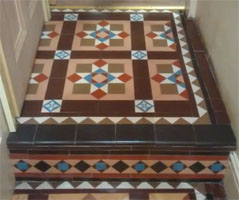
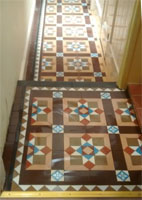
Restoration and renovation work on a geometric tiled hall in a private property at Caergwrle.
Along with some damaged and dirty tiling the hallway had a sunken depression that needed to be lifted to give a level surface. Around six square metres of tiling was lifted and subsequently cleaned and refurbished in order to be put back once the underlying concrete floor had been raised. Loose and weak cement mortar was removed and the floor was raised and levelled with a cement screed. Following the addition of a de-coupling membrane the reclaimed tiles were replaced and replica tiling was used to replace other broken tiling.
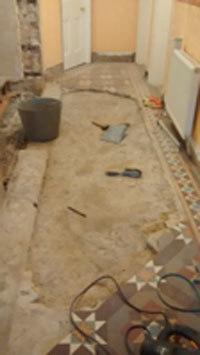
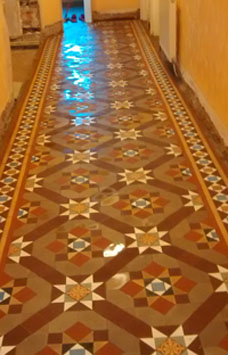
Completed restoration of a late Victorian tiled shop front and interior on the High Street, Egham, Surrey.
A former butcher's now converted into a Bar and Restaurant, grade 2 listed shop front, had suffered damage to large areas of the original tiling. Following a survey of the exterior and interior, Rieveley Ceramics manufactured replica tiling to replace the missing and badly damaged tiles.
Onsite work commenced in mid October for two weeks. The busy restaurant and bar trade were able to continue during the period of the restoration work and whilst the replica tiles were installed and the conservation work took place.
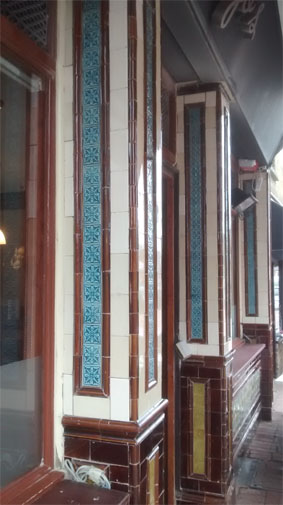
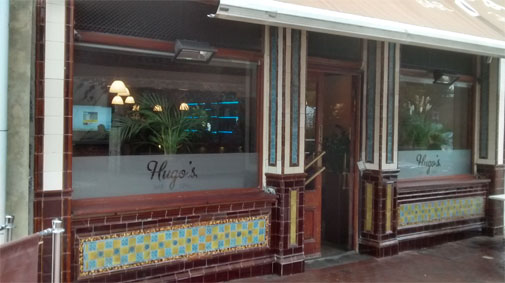
Rieveley Ceramics 2025 | All Rights
Reserved |
Privacy Policy
| Built by